 W
WMicrosoft Office, or simply Office, is a family of client software, server software, and services developed by Microsoft. It was first announced by Bill Gates on August 1, 1988, at COMDEX in Las Vegas. Initially a marketing term for an office suite, the first version of Office contained Microsoft Word, Microsoft Excel, and Microsoft PowerPoint. Over the years, Office applications have grown substantially closer with shared features such as a common spell checker, OLE data integration and Visual Basic for Applications scripting language. Microsoft also positions Office as a development platform for line-of-business software under the Office Business Applications brand. On July 10, 2012, Softpedia reported that Office was being used by over a billion people worldwide.
 W
WOffice 365 is a line of subscription services offered by Microsoft as part of the Microsoft Office product line. The brand encompasses plans that allow use of the Microsoft Office software suite over the life of the subscription, as well as cloud-based software as a service products for business environments, such as hosted Exchange Server, Skype for Business Server, and SharePoint, among others. All Office 365 plans include automatic updates to their respective software at no additional charge, as opposed to conventional licenses for these programs—where new versions require purchase of a new license.
 W
WMicrosoft Office 2000 is a release of Microsoft Office, an office suite developed and distributed by Microsoft for the Windows family of operating systems. Office 2000 was released to manufacturing on March 29, 1999, and was made available to retail on June 7, 1999. It is the successor to Office 97 and the predecessor to Office XP.
 W
WMicrosoft Office 2001 is a suite of productivity software for Mac OS 8, Mac OS 9, or the Classic environment in Mac OS X. It is the Mac equivalent of Office 2000. It was developed by Microsoft and announced on September 13, 2000 before its release on October 11, 2000.
 W
WMicrosoft Office 2003 is an office suite developed and distributed by Microsoft for its Windows operating system. Office 2003 was released to manufacturing on August 19, 2003, and was later released to retail on October 21, 2003. It was the successor to Office XP and the predecessor to Office 2007.
 W
WMicrosoft Office 2007 is a version of Microsoft Office, a family of office suites and productivity software for Windows, developed and published by Microsoft. It was released to manufacturing on November 3, 2006; it was subsequently made available to volume license customers on November 30, 2006, and later to retail on January 30, 2007, the same respective release dates of Windows Vista. It was preceded by Office 2003 and succeeded by Office 2010.
 W
WMicrosoft Office 2010 is a version of the Microsoft Office productivity suite for Microsoft Windows. Office 2010 was released to manufacturing on April 15, 2010, and was later made available for retail and online purchase on June 15, 2010. It is the successor to Office 2007 and the predecessor to Office 2013. Research and development of Office 2010 began in 2006, before the release of its predecessor.
 W
WMicrosoft Office 2013 is a version of Microsoft Office, a productivity suite for Microsoft Windows. It is the successor to Microsoft Office 2010 and the predecessor to Microsoft Office 2016. It includes extended file format support, user interface updates and support for touch among its new features. Office 2013 is suitable for IA-32 and x64 systems and requires Windows 7, Windows Server 2008 R2 or a later version of either. A version of Office 2013 comes included on Windows RT devices. Mainstream support ended on April 10, 2018. Extended support ends on April 11, 2023.
 W
WMicrosoft Office 2016 is a version of the Microsoft Office productivity suite, succeeding both Office 2013 and Office for Mac 2011 and preceding Office 2019 for both platforms. It was released on macOS on July 9, 2015, and on Microsoft Windows on September 22, 2015, for Office 365 subscribers. Mainstream support ended on October 13, 2020, and most editions have extended support up to October 14, 2025. The perpetually licensed version on macOS and Windows was released on September 22, 2015. Office 2016 requires Windows 7 SP1, Windows Server 2008 R2 SP1 or macOS X Yosemite or later. Since its successor Office 2019 only supports Windows 10 or Windows Server 2019, this is the last version of Microsoft Office compatible with Windows 7, Windows Server 2008 R2, Windows 8, Windows 8.1, Windows Server 2012, Windows Server 2012 R2, and Windows Server 2016.
 W
WMicrosoft Office 2019 is the current version of Microsoft Office for both Windows and Mac. It is the successor to Office 2016 and will be succeeded by Office 2022 in the second half of 2021. It was released to general availability for Windows 10 and for macOS on September 24, 2018. Some features that had previously been restricted to Office 365 subscribers are available in this release. Mainstream support for Office 2019 will end on October 10, 2023. Unlike other versions of Microsoft Office, Office 2019 will only get two years of extended support, which means that support for Office 2019 will end on the same day as support for Office 2016 will, on October 14, 2025.
 W
WMicrosoft Access is a database management system (DBMS) from Microsoft that combines the relational Microsoft Jet Database Engine with a graphical user interface and software-development tools. It is a member of the Microsoft Office suite of applications, included in the Professional and higher editions or sold separately. It is also a member of the Microsoft 365 suite. Latest versions have more protections. A trial version of the software is available.
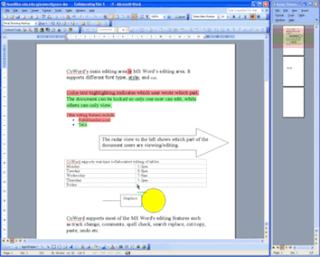 W
WCoWord is a software add-on to Microsoft Word to enable multiple users to edit the same document over the Internet with MS Word. It is a part of the CoOffice suite of collaboration tools for Microsoft Office.
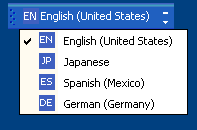 W
WThe Text Services Framework (TSF) is a COM framework and API in Windows XP and later Windows operating systems that supports advanced text input and text processing. The Language Bar is the core user interface for Text Services Framework.
 W
WDocs.com was a website where users can discover, upload and share Office documents. Supported file types included Word documents, Excel spreadsheets, PowerPoint presentations, Mix video presentations and Sways. Users could also add PDFs and URLs on to their page. Docs.com was a part of Microsoft Office Online.
 W
WMicrosoft Entourage is a discontinued e-mail client and personal information manager that was developed by Microsoft for Mac OS 8.5 and later. Microsoft first released Entourage in October 2000 as part of the Microsoft Office 2001 office suite; Office 98, the previous version of Microsoft Office for the classic Mac OS included Outlook Express 5. The last version was Entourage: Mac 2008, part of Microsoft Office 2008 for Mac, released on January 15, 2008. Entourage was replaced by Outlook for Macintosh in Microsoft Office for Mac 2011, released on October 26, 2010.
 W
WMicrosoft Excel is a spreadsheet developed by Microsoft for Windows, macOS, Android and iOS. It features calculation, graphing tools, pivot tables, and a macro programming language called Visual Basic for Applications (VBA). It has been a very widely applied spreadsheet for these platforms, especially since version 5 in 1993, and it has replaced Lotus 1-2-3 as the industry standard for spreadsheets. Excel forms part of the Microsoft Office suite of software.
 W
WMicrosoft FrontPage is a discontinued WYSIWYG HTML editor and website administration tool from Microsoft for the Microsoft Windows line of operating systems. It was branded as part of the Microsoft Office suite from 1997 to 2003. Microsoft FrontPage has since been replaced by Microsoft Expression Web and SharePoint Designer, which were first released in December 2006 alongside Microsoft Office 2007, but these two products were also discontinued in favor of a web-based version of SharePoint Designer, as those three HTML editors were desktop applications.
 W
WMicrosoft InfoPath is a software application for designing, distributing, filling and submitting electronic forms containing structured data. Microsoft initially released InfoPath as part of the Microsoft Office 2003 family. The product features a WYSIWYG form designer in which the various controls are bound to data, represented separately as a hierarchical tree view of folders and data fields.
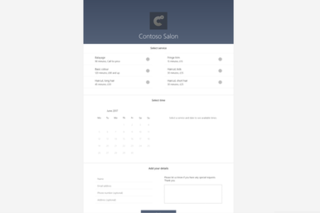 W
WMicrosoft Bookings is a scheduling tool and is part of the Microsoft Office family of products. Generally released by Microsoft in March 2017, Bookings allows customers of small businesses and companies to book appointments with the company. The application is available to Business Premium subscribers to Office 365 and offers integration with Microsoft Teams and the outgoing Skype for Business, however, this feature was not available from launch.
 W
WMicrosoft Classroom was an online blended learning platform for schools that aimed to simplify grading assignments and student communication in a paperless way. It was introduced for Office 365 Education subscribers in April 2016.
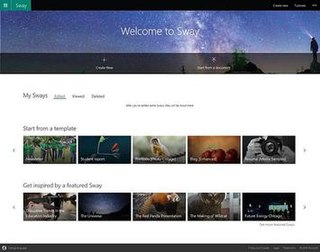 W
WMicrosoft Sway is a presentation program and is part of the Microsoft Office family of products. Sway was offered for general release by Microsoft in August 2015. It allows users who have a Microsoft account to combine text and media to create a presentable website. Users can pull content locally from the device in use, or from internet sources such as Bing, Facebook, OneDrive, and YouTube. An unrelated web editing program in the evolution of web designers also developed by Microsoft in the past was Microsoft FrontPage and Microsoft Expression Web. These programs, however, did not include a method for hosting websites the way that Sway does.
 W
WMicrosoft Office 3.0 was a release of Microsoft Office. It was the second major release for the Microsoft Windows operating system and the third on the Macintosh, preceding Microsoft Office 4.0. Omitting version 2 entirely on Windows, Microsoft released Office 3.0 on August 30, 1992. Previously, these components were distributed separately for Windows, and it was with Microsoft Office that they were combined as a full office suite.
 W
WMicrosoft Office 95, also known as Microsoft Office for Windows 95, is a version of Microsoft Office released on August 24, 1995, along with Windows 95. It is the successor to Office 4.3 and is the first 32-bit version of Microsoft Office. While designed specifically for Windows 95, it also works on Windows NT 3.51, Windows NT 4.0, and Windows 98. As it is 32-bit, it does not run on Windows 3.x or earlier versions of Windows. It is also not supported on Windows NT 3.1 or Windows NT 3.5, despite these operating systems being 32-bit. Office 95 was succeeded by Office 97 on November 19, 1996. All support for Microsoft Office 95 ended on December 31, 2001, the same day as Windows 95.
 W
WMicrosoft Office 97 is a major milestone release of Microsoft Office, which includes hundreds of new features and improvements over its predecessor, Microsoft Office 95. Office 97 introduced "Command Bars," a paradigm in which menus and toolbars were made more similar in capability and visual design. It also featured natural language systems and sophisticated grammar checking. It was published on CD-ROM as well as on a set of 44 3½-inch floppy disks. Released on November 19, 1996, the suite runs on Windows NT 3.51 SP5, Windows 95, Windows NT 4.0, Windows 98, Windows 2000, and Windows Me. It is the last version to support Windows NT 3.51 as its successor, Office 2000, is not compatible with it. Two service releases were released for Office 97. SR-2 solved the year 2000 problem in Office 97.
 W
WMicrosoft Office 98 Macintosh Edition is a version of Microsoft Office for the classic Mac OS, unveiled at Macworld Expo/San Francisco on January 6, 1998. It introduced the Internet Explorer 4.0 browser and Outlook Express, an Internet e-mail client and usenet newsgroup reader. Office 98 was re-engineered by Microsoft's Macintosh Business Unit to satisfy customers' desire for more Mac-like software.
 W
WOffice 2004 for Mac is a version of Microsoft Office developed for Mac OS X. It is equivalent to Office 2003 for Windows. The software was originally written for PowerPC Macs, so Macs with Intel CPUs must run the program under Mac OS X's Rosetta emulation layer. For this reason, it is not compatible with Mac OS X 10.7 and newer.
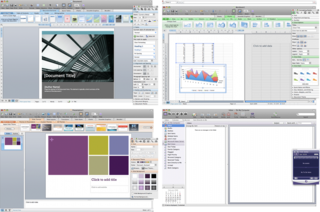 W
WMicrosoft Office 2008 for Mac is a version of the Microsoft Office productivity suite for Mac OS X. It supersedes Office 2004 for Mac and is the Mac OS X equivalent of Office 2007. Office 2008 was developed by Microsoft's Macintosh Business Unit and released on January 15, 2008. Office 2008 was followed by Microsoft Office for Mac 2011 released on October 26, 2010, requiring a Mac with an Intel processor and Mac OS version 10.5 or better. Office 2008 is also the last version to feature Entourage, which was replaced by Outlook in Office 2011. Microsoft stopped supporting Office 2008 on April 9, 2013.
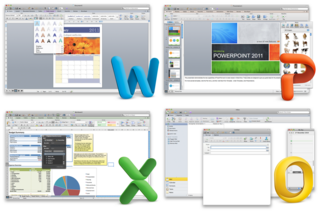 W
WMicrosoft Office for Mac 2011 is a version of the Microsoft Office productivity suite for Mac OS X. It is the successor to Microsoft Office 2008 for Mac and is comparable to Office 2010 for Windows. Office 2011 was followed by Microsoft Office 2016 for Mac released on September 22, 2015, requiring a Mac with an x64 Intel processor and OS X Yosemite or later. Office for Mac 2011 is no longer supported as of October 10, 2017.
The Office Assistant is a discontinued intelligent user interface for Microsoft Office that assisted users by way of an interactive animated character which interfaced with the Office help content. It was included in Microsoft Office for Windows, in Microsoft Publisher and Microsoft Project, Microsoft FrontPage and Microsoft Office for Mac.
 W
WMicrosoft Office Live is a discontinued web-based service providing document sharing and website creation tools for consumers and small businesses. Its successor was branded Windows Live. Office Live consisted of two services, Office Live Workspace, which was superseded by OneDrive, and Office Live Small Business, which was superseded by Office 365.
 W
WMicrosoft Office XP is an office suite created and distributed by Microsoft for the Windows operating system. Office XP was released to manufacturing on March 5, 2001, and was later made available to retail on May 31, 2001. It is the successor to Office 2000 and the predecessor of Office 2003.
 W
WMicrosoft OneDrive is a file hosting service and synchronization service operated by Microsoft as part of its web version of Office. First launched in August 2007, OneDrive allows users to store files and personal data like Windows settings or BitLocker recovery keys in the cloud, share files, and sync files across Android, Windows Phone, and iOS mobile devices, Windows and macOS computers, and the Xbox 360 and Xbox One consoles. Users can upload Microsoft Office documents to OneDrive.
 W
WMicrosoft OneNote is a note-taking program for free-form information gathering and multi-user collaboration. It gathers users' notes, drawings, screen clippings, and audio commentaries. Notes can be shared with other OneNote users over the Internet or a network. OneNote is available as part of the Microsoft Office Suite, it is also available as a free, standalone app via the app stores of Windows 10, macOS, iOS and Android. Microsoft also provides a web-based version of OneNote as part of OneDrive and Office for the web; this version enables users to edit notes in a web browser.
 W
WMicrosoft Outlook is a personal information manager software system from Microsoft, available as a part of the Microsoft Office suite. Though primarily an email client, Outlook also includes such functions as calendaring, task managing, contact managing, note-taking, journal logging, and web browsing.
 W
WOutlook on the web is a personal information manager web app from Microsoft. It is included in Microsoft 365, Office 365, Exchange Server 2016/2019, and Exchange Online. It includes a web-based email client, a calendar tool, a contact manager, and a task manager. It also includes add-in integration, Skype on the web, and alerts as well as unified themes that span across all the web apps. Outlook on the web is navigated using the App Launcher icon which brings down a list of web apps from which the user may choose. In 2015, Microsoft started upgrading Outlook.com and Outlook on the web to use the Office 365 infrastructure, which was almost complete in January 2017 after the next version of Outlook.com was released.
 W
WOutlook.com is a personal information manager web app from Microsoft consisting of webmail, calendaring, contacts, and tasks services. Founded in 1996 by Sabeer Bhatia and Jack Smith, Hotmail was acquired by Microsoft in 1997 for an estimated $400 million and relaunched as MSN Hotmail, later rebranded to Windows Live Hotmail as part of the Windows Live suite of products. Microsoft phased out Hotmail in October 2011, relaunching the service as Outlook.com in 2012.
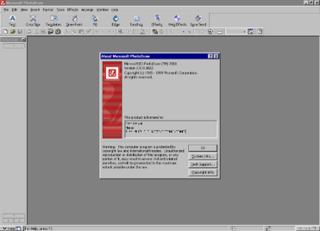 W
WMicrosoft PhotoDraw 2000 is a discontinued vector graphics and raster imaging software package developed by Microsoft.
 W
WMicrosoft Office Picture Manager is a raster graphics editor introduced in Microsoft Office 2003 and included up to Office 2010. It is the replacement to Microsoft Photo Editor introduced in Office 97 and included up to Office XP.
 W
WMicrosoft PowerPoint is a presentation program, created by Robert Gaskins and Dennis Austin at a software company named Forethought, Inc. It was released on April 20, 1987, initially for Macintosh System Operating system based computers only. Microsoft acquired PowerPoint for about $14 million three months after it appeared. This was Microsoft's first significant acquisition, and Microsoft set up a new business unit for PowerPoint in Silicon Valley where Forethought had been located.
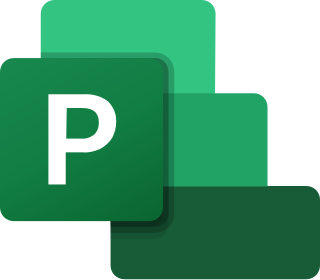 W
WMicrosoft Project is a project management software product, developed and sold by Microsoft. It is designed to assist a project manager in developing a schedule, assigning resources to tasks, tracking progress, managing the budget, and analyzing workloads.
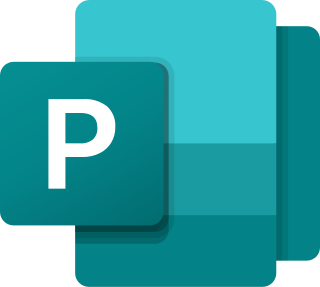 W
WMicrosoft Publisher is a desktop publishing application from Microsoft, differing from Microsoft Word in that the emphasis is placed on page layout and design rather than text composition and proofing.
 W
WMicrosoft SharePoint Designer (SPD), formerly known as Microsoft Office SharePoint Designer, is a discontinued HTML editor freeware for creating or modifying Microsoft SharePoint sites, workflows and web pages. It is a part of Microsoft SharePoint family of products. SharePoint Designer 2007 is a part of Microsoft Office 2007 family, but is not included in any of the Microsoft Office suites. SharePoint Designer 2013 is the last version of this product.
 W
WMicrosoft SharePoint Workspace, previously known as Microsoft Office Groove, is a discontinued desktop application designed for document collaboration in teams with members who are regularly off-line or who do not share the same network security clearance. It is no longer included with Microsoft Office 2013. It has been replaced by a web-based service called SharePoint.
 W
WSkype for Business is enterprise instant messaging software developed by Microsoft as part of the Microsoft Office suite. It is designed for use with the on-premises Skype for Business Server software, and a software as a service version offered as part of Office 365. It supports text, audio, and video chat, and integrates with Microsoft Office components such as Exchange and SharePoint.
 W
WMicrosoft Teams is a proprietary business communication platform developed by Microsoft, as part of the Microsoft 365 family of products. Teams primarily competes with the similar service Slack, offering workspace chat and videoconferencing, file storage, and application integration. Teams is replacing other Microsoft-operated business messaging and collaboration platforms, including Skype for Business and Microsoft Classroom.
 W
WMicrosoft Visio is a diagramming and vector graphics application and is part of the Microsoft Office family. The product was first introduced in 1992, made by the Shapeware Corporation. It was acquired by Microsoft in 2000.
 W
WMicrosoft Vizact 2000 is a discontinued program that allowed creation of interactive documents using HTML+TIME, adding effects such as animation. It allowed users to create dynamic documents for the Web. It was preceded by Liquid Motion. Vizact 2000 was "the first document activation application" according to Microsoft. Development of Vizact 2000 was ended due to unpopularity and was discontinued on April 1, 2000."Vizact helps solve this problem by giving Office users the ability to create documents that harness the dynamic nature of the Web, without having to be Web authors or programmers." Karl Jacob, product unit manager of Microsoft's Document Activation Group.
 W
WThe first version of Microsoft Word was developed by Charles Simonyi and Richard Brodie, former Xerox programmers hired by Bill Gates and Paul Allen in 1981. Both programmers worked on Xerox Bravo, the first WYSIWYG word processor. The first Word version, Word 1.0, was released in October 1983 for Xenix and MS-DOS; it was followed by four very similar versions that were not very successful. The first Windows version was released in 1989, with a slightly improved interface. When Windows 3.0 was released in 1990, Word became a huge commercial success. Word for Windows 1.0 was followed by Word 2.0 in 1991 and Word 6.0 in 1993. Then it was renamed to Word 95 and Word 97, Word 2000 and Word for Office XP. With the release of Word 2003, the numbering was again year-based. Since then, Windows versions include Word 2007, Word 2010, Word 2013, Word 2016, and most recently, Word for Office 365.
 W
WMicrosoft Word is a word processor developed by Microsoft. It was first released on October 25, 1983 under the name Multi-Tool Word for Xenix systems. Subsequent versions were later written for several other platforms including IBM PCs running DOS (1983), Apple Macintosh running the Classic Mac OS (1985), AT&T UNIX PC (1985), Atari ST (1988), OS/2 (1989), Microsoft Windows (1989), SCO Unix (1994), and macOS (2001).
 W
WMicrosoft Word Viewer is a discontinued freeware program for Microsoft Windows that can display and print Microsoft Word documents. Word Viewer allows text from a Word document to be copied into clipboard and pasted into a word processor. The last version was Word Viewer 2003 Service Pack 3 released in 2007.
 W
WYammer is a freemium enterprise social networking service used for private communication within organizations. Access to a Yammer network is determined by a user's Internet domain so that only individuals with approved email addresses may join their respective networks.